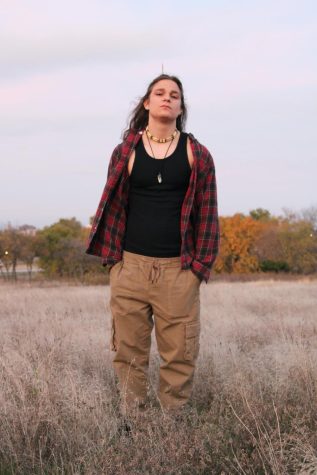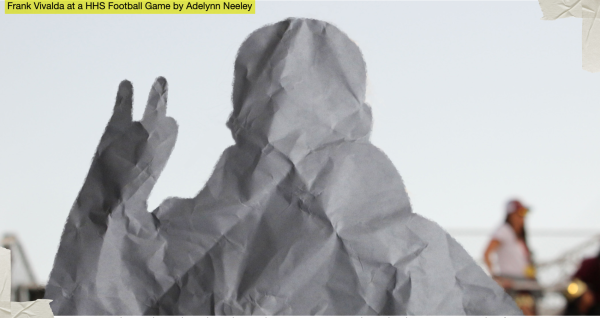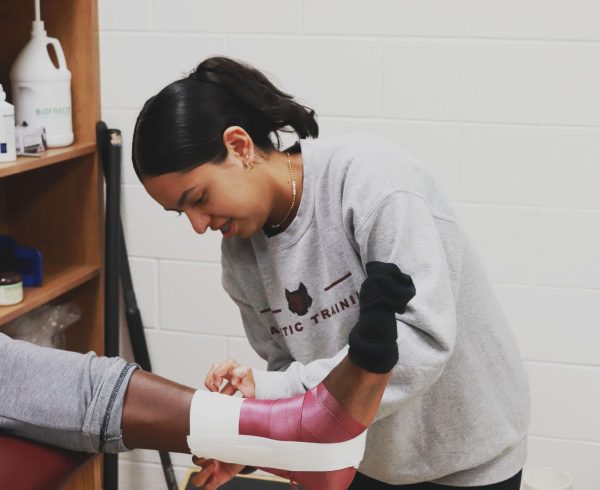Our Voice
One student’s thoughts on Native appropriation
February 15, 2023

Senior Gregory Conrad could not forget the sight of an Instagram post featuring a model posing alongside the shores of a beach, adorning her head with a band of embellished beadwork that flashed a sweeping range of feathers. At first glance, the photo seemed like it was paying homage toward Native culture.
Except, Conrad, a descendant of the Choctaw Nation, didn’t see it that way. He saw it as an ignorant portrayal of Indigenous tradition, and an exploit of the headdress like it was a mere accessory.
Just like Natives have traditionally braided their hair as a sacred symbol of their heritage for ages, Conrad feels Indigenous cultural appropriation has weaved and unfurled into societal norms for decades.
“A lot of these ceremonial headdresses, masks and whatnot that people are waltzing around in—it’s essentially religious clothing to us,” Conrad said. “If it isn’t a part of your culture, then you shouldn’t wear it. I don’t get why people always step over that line.”
According to an article from Lakota People’s Law, Indigenous headdresses are not created for fashionable commerce or everyday use. Although the usage of the headdress isn’t common, apart from within the Nations of Mohawk, Pequot, Cree, Mohican, Huron, and others, it was earned to honor a member’s significant contribution toward their Nation—such as going into battle. Therefore, as expressed by sites like Tribal Trade, wearing the headdress and other similar Indigenous regalia is considered offensive.
Another aspect is tying braids. In the past, the ancestors of Natives may have done the hairstyle as a symbol of bravery and power within their history, however it is currently used as such to honor their ancestors.
With this custom established, there also comes a set of rules.
“Essentially, it is seen as a strong bonding experience and a big sign of trust to allow another person to braid or touch your hair,” Conrad said.
It’s also considered very disrespectful in Indigenous culture to touch someone’s hair without consent. In the past, it was believed that someone else’s intentions could be stored within the hair if it was touched by that person. If their intentions were ill, then the latter would gain bad energy; this belief came from the Indigenous ideology that spirits lived in hair.
“The hair represents your life, like life goes on. As you get older and older, your hair gets longer, and [it] represents a free flowingness of life,” Conrad said. “Braids started because it’s a convenient way to keep your hair out of your face and the three strands represent mind, body, and spirit. When you tie them up, you’re connected.”
While Conrad believes that normalizing regular Native clothing styles is harmless, ceremonial clothes are a different case. Sometimes called opening masks, Conrad says ceremonial masks tend to be appropriated by non-Natives; these hand-crafted accessories were used in ritual dances and given to people for various specific reasons.
“As far as I know, it could be different for different tribes but the masks were given to each person based on their Native names by a shaman or an elder,” Conrad said.
The Native names came from “spirit animals” or representative animal traits.
“For instance, a famous Native American, Sitting Bull, was given his name for his bravery in battle, displaying the traits of a bull,” Conrad said. “When you read in a history book, all these weird names like, big little bird, relate back to masks and clothing.”
Conrad explains further that European colonization and the spread of the English language has extinguished Native dialects over the centuries and caused the prevalent usage of English names for Native people.
“Even before the Trail of Tears and such, most tribes were speaking English,” Conrad said. According to an NPR article, Native Americans have felt dehumanized as a result of the way European colonists have treated them via usage of derogatory language and assimilation camps.
Within a century of contact with Columbus and the European explorers that followed, virtually 90 percent of the Native population was wiped out, and with society’s continued oppression paired with its ignorance toward Indigenous culture, Conrad believes the memory of his people will cease to exist.
“Every year there’s less and less Native Americans being born; A lot of [people] don’t know, but it’s slowly going down,” Conrad said. “And, you know, eventually, there won’t be Native Americans left just from getting bred out.”
Executive director of Juniper Networks Maria Scott, who is a Cherokee descendant and a donor of the Lakota Youth organization stated that representation of Indigenous culture needs to be enriched, not only through history books, but also the art space. Everyone sees the commercialization of Tribal arts, but what they don’t see are the colors of Indigenous culture—they are as significant as the royal crests from the royal family and the Celtic knot from the Irish or the Scottish people.
Scott believes the government is suppressing the truth now more than ever before. “This is American history,” Scott said. “Today, we get to listen to political leaders talk about immigrants coming here, having no purpose or no rights when the heritage of these people who are talking came and did exactly what they’re saying other people are doing, ignoring the fact that [their ancestors] were once immigrants on this land as well.”











